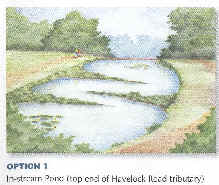|
 Option 1: in-stream pond 'A'
upstream of Havelock Road Option 1: in-stream pond 'A'
upstream of Havelock Road
The
construction of an in-stream pond at the most upstream part of the
gardens, created by building a dam wall at its downstream end with
simple controls for water flow during both normal and flood conditions.
Excavations would need to avoid electrical cables to the north and a
water main to the south.
Principal features of
the pond being:
-
a
meandering channel with wetland areas which would be inundated
to form a full pond during flood conditions;
-
deeper
'deposition' pool area within the meandering channel;
-
the construction
of a gravel footpath around the perimeter with stream crossings at
each end;
-
wetland/reed bed
planting along the meanders, and other perimeter planting.
Pros & Cons:
although option 1 would improve water quality for the rest of the
stretch of the stream, and offers good access, it is quite remote from
Coy Pond. It's limited size would have only a moderate impact on
improving water quality and flood water storage. It does, however,
allow an opportunity to remove existing concrete walls from the stream. |